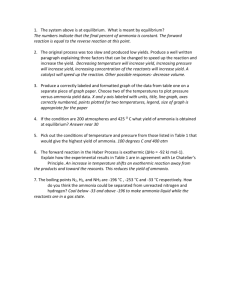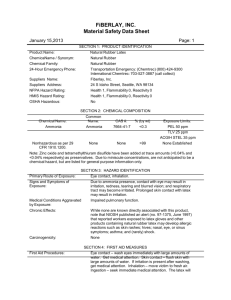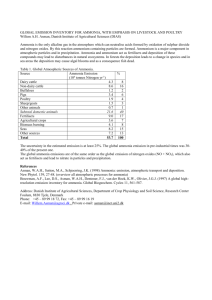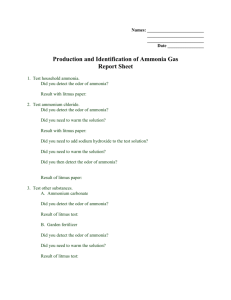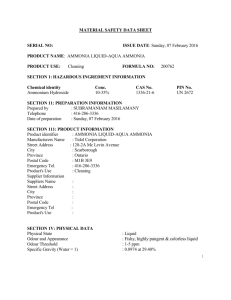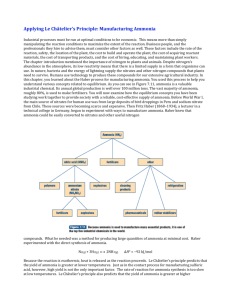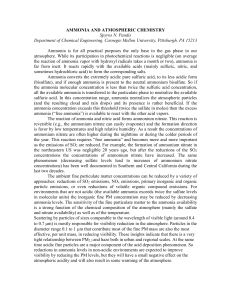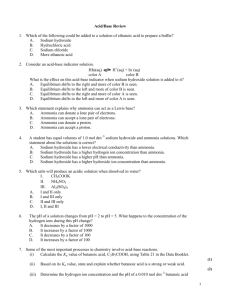File
advertisement
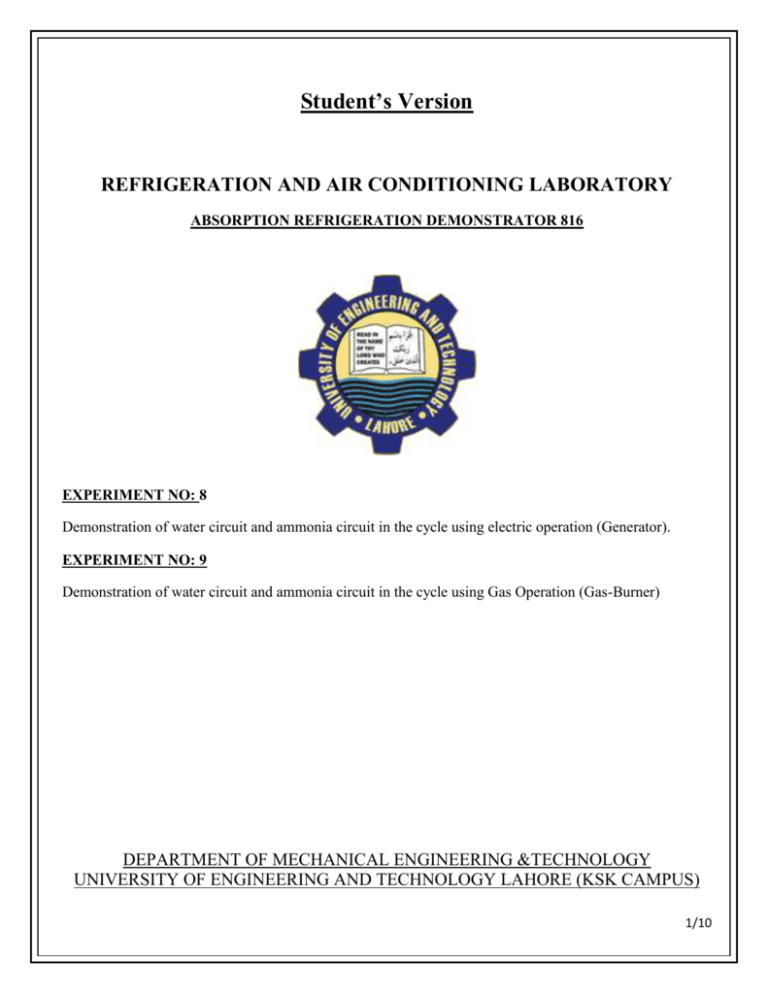
Student’s Version REFRIGERATION AND AIR CONDITIONING LABORATORY ABSORPTION REFRIGERATION DEMONSTRATOR 816 EXPERIMENT NO: 8 Demonstration of water circuit and ammonia circuit in the cycle using electric operation (Generator). EXPERIMENT NO: 9 Demonstration of water circuit and ammonia circuit in the cycle using Gas Operation (Gas-Burner) DEPARTMENT OF MECHANICAL ENGINEERING &TECHNOLOGY UNIVERSITY OF ENGINEERING AND TECHNOLOGY LAHORE (KSK CAMPUS) 1/10 2/10 3/10 4/10 EXPERIMENT # 08 OBJECTIVE: Demonstration of water circuit and ammonia circuit in the cycle using electric operation(Generator). APPARATUS: Absorption refrigeration Demonstrator BASIC PRINCIPALS Absorption refrigeration operates on two fundamental principles: 1. The ability of large quantities of ammonia gas to be absorbed into cold water at low pressure and then at higher temperature and pressure to be driven out again. 2. The ability to condense ammonia vapor at a high pressure and temperature and to evaporate it at low temperature in the presence of an inert gas with the total pressure remaining constant. During the evaporation process a heat can be transferred to the ammonia. With reference to the above principals absorption refrigerator incorporated in the Absorption Refrigeration Demonstrator operates as follows: LIQUID CIRCUIT The Absorber Vessel (F) contains approximately 65% water and 35% ammonia by weight. This solution is commonly called aqua-ammonia. The liquid from the Absorber Vessel flows through the Liquid Heat Exchanger (G) to the Vapor Pump (I) where due to the application of heat and subsequent increase in temperature some of the ammonia vapor is driven out of the solution. This vapor forms bubbles, which push the liquid up the pump tube. For this reason the device is sometimes called a Vapor Bubble Pump. The liquid falls downwards through the Generator (A) where it is further heated, its temperature raised to approaching 200℃ and further ammonia is driven out of the solution. This produces a weak solution that contains approximately 10% ammonia. The hot weak solution then passes from the Generator (A) back through the Liquid Heat Exchanger (G), where it gives up heat to the to the incoming strong solution entering from the Absorber Vessel (F). it then passes to the top of the Absorber Vessel. AMMONIA CIRCUIT The ammonia vapor from the Vapor Pump (I) has a temperature of approximately 150℃ when it leaves the Generator (A). Under these conditions the gas contains a quantity of water vapor that can be condensed in a water separator of rectifier positioned before the Condenser where the temperature drops be heat rejection to ambient. The pure ammonia vapor then enters the Condenser (B) at an approximate temperature of 70℃. The condenser consists of a finned tube and heat is rejected at approximately ambient temperature. At this temperature and a pressure of approximately 256 bar the ammonia vapor condenses. The liquid ammonia passes into the tubular coil of the Evaporator © through the liquid (J) where it wets the internal surface of the evaporator tube. 5/10 HYDROGEN CIRCUIT Hydrogen gas passes over the wetted surface of the evaporator tube and in the first part of the evaporator the ammonia evaporates into the hydrogen at a temperature of between -30 and -18℃. In this section of the evaporator the pressure is approximately 25 bars with the ammonia at a partial pressure of approximately 1bar and the hydrogen at a partial pressure of approx 24 bars. As the ammonia continues to evaporate into the hydrogen the partial pressure of the ammonia gradually increases and the evaporating temperature also increases. At the end of the evaporator the ammonia has an evaporating temperature of approximately -5℃. The weight of the mixture of hydrogen and ammonia is now considerably greater than the weight of almost pure hydrogen. The heavier mixture drops through the Gas Heat Exchanger (D) and Absorber (E) and reaches the upper surface of the Absorber Vessel (F). In this process the gas which is rich in ammonia vapor meets the weak solution from the Generator (A) in the Absorber (E). The Absorber has a large surface area and a temperature close to ambient. The weak solution therefore remains relatively cool and absorbs the ammonia vapor from the gas. The hydrogen being inert remains unaffected in this process but becomes more pure. The pure hydrogen is therefore able to leave the top of the Absorber Vessel (F) while the rich solution (water and ammonia) leaves the bottom of the Absorber Vessel to repeat the cycle. OPERATING PROCEDURE: 1. Electric Operation: Turn on the main switch and the one internal lamp will light. The digital temperature indicator and digital wattmeter displays will also illuminate. 2. Refrigeration Load (Duty): This is determined by the input to the electric heating element inside the cabinet and is controlled by the evaporator input control setting. With the changeover switch in the left position the digital wattmeter displays the evaporator heat input rate. 3. Generator Power Input: This is determined by the input to the electric heating element inside the Generator and is controlled by the generator input control setting. With the changeover switch in the right position the digital wattmeter displays the generator heat input rate. 4. Energy Meter: Electrical input to drive the Generator is measured by timing the integrating energy meter. 5. Digital Temperature Indicator: This becomes operative as soon as the electrical supply is switched on. The temperature may be measured at 10 points in the circuit by selecting stations 0 to 9 on the switch. The individual temperature points referred to in the SCHEMATIC DIAGRAM and UNITS AND SYMBOLS are selected and displayed on the indicator by switching to the corresponding number on the selector switch below the indicator. 6. Digital Wattmeter: This becomes operative as soon as the electrical supply is switched on. The digital wattmeter comprises a 3/12 digit true power AC wattmeter and current transformer. The current drawn by the evaporator heater or generator is sensed by a current transformer and sent as a 𝑚𝐴 signal to the 6/10 wattmeter. AV volts are also monitored by the wattmeter and processed to display energy consumption rate (Watt). 7. Thermostat: The thermostat controls the cabinet temperature. The reading is taken with the number (07) in the top vertical position. 0=Hot; 7=Cold; 𝑡9 = Cabinet Temperature CALCULATIONS: 200 rev of energy meter= 1 kWh; 1 kWh = 3.6x106 J; COP = qg / qe; COP = Te (Tg - Tc) / Tg (Ta - Te) Where: Tg = Temperature of Generator = (T1+T8) / 2 ; Te = Temperature of Evaporator = (T5+T4) / 2 ; Tc = Temperature of Condenser = (T3+T2) / 2 Ta = Temperature of Absorber = (T7+T6) / 2 TABLE/OBSERVATIONS: Sr. X No. (sec) Heat Input qe qg (kWh) (W) (W) T0 T1 T2 T3 T4 T5 T6 T7 T8 T9 (˚C) (˚C) (˚C) (˚C) (˚C) (˚C) (˚C) (˚C) (˚C) (˚C) COP 1 2 3 4 5 SPECIMEN CALCULATIONS: Tg = Temperature of Generator = (T1+T8) / 2 = __________OC Tc = Temperature of Condenser = (T3+T2) / 2 = __________OC Te = Temperature of Evaporator = (T5+T4) / 2 = __________OC Ta = Temperature of Absorber = (T7+T6) / 2 = __________OC COP = Te (Tg - Tc) / Tg (Ta - Te) = _____________________ PLOTS: Draw the following plots: 1- COP Vs evaporator Load 2- COP Vs condenser outlet temperature 3- Heat input rate Vs condenser outlet temperature COMMENTS: 7/10 EXPERIMENT # 09 OBJECTIVE: Demonstration of water circuit and ammonia circuit in the cycle using Gas Operation (Gas-Burner) APPARATUS: Absorption refrigeration Demonstrator BASIC PRINCIPALS Absorption refrigeration operates on two fundamental principles: 1. The ability of large quantities of ammonia gas to be absorbed into cold water at low pressure and then at higher temperature and pressure to be driven out again. 2. The ability to condense ammonia vapor at a high pressure and temperature and to evaporate it at low temperature in the presence of an inert gas with the total pressure remaining constant. During the evaporation process a heat can be transferred to the ammonia. With reference to the above principals absorption refrigerator incorporated in the Absorption Refrigeration Demonstrator operates as follows: LIQUID CIRCUIT The Absorber Vessel (F) contains approximately 65% water and 35% ammonia by weight. This solution is commonly called aqua-ammonia. The liquid from the Absorber Vessel flows through the Liquid Heat Exchanger (G) to the Vapor Pump (I) where due to the application of heat and subsequent increase in temperature some of the ammonia vapor is driven out of the solution. This vapor forms bubbles, which push the liquid up the pump tube. For this reason the device is sometimes called a Vapor Bubble Pump. The liquid falls downwards through the Generator (A) where it is further heated, its temperature raised to approaching 200℃ and further ammonia is driven out of the solution. This produces a weak solution that contains approximately 10% ammonia. The hot weak solution then passes from the Generator (A) back through the Liquid Heat Exchanger (G), where it gives up heat to the to the incoming strong solution entering from the Absorber Vessel (F). it then passes to the top of the Absorber Vessel. AMMONIA CIRCUIT The ammonia vapor from the Vapor Pump (I) has a temperature of approximately 150℃ when it leaves the Generator (A). Under these conditions the gas contains a quantity of water vapor that can be condensed in a water separator of rectifier positioned before the Condenser where the temperature drops be heat rejection to ambient. The pure ammonia vapor then enters the Condenser (B) at an approximate temperature of 70℃. The condenser consists of a finned tube and heat is rejected at approximately ambient temperature. At this temperature and a pressure of approximately 256 bar the ammonia vapor condenses. The liquid ammonia passes into the tubular coil of the Evaporator © through the liquid (J) where it wets the internal surface of the evaporator tube. 8/10 HYDROGEN CIRCUIT Hydrogen gas passes over the wetted surface of the evaporator tube and in the first part of the evaporator the ammonia evaporates into the hydrogen at a temperature of between -30 and -18℃. In this section of the evaporator the pressure is approximately 25 bars with the ammonia at a partial pressure of approximately 1bar and the hydrogen at a partial pressure of approx 24 bars. As the ammonia continues to evaporate into the hydrogen the partial pressure of the ammonia gradually increases and the evaporating temperature also increases. At the end of the evaporator the ammonia has an evaporating temperature of approximately -5℃. The weight of the mixture of hydrogen and ammonia is now considerably greater than the weight of almost pure hydrogen. The heavier mixture drops through the Gas Heat Exchanger (D) and Absorber (E) and reaches the upper surface of the Absorber Vessel (F). In this process the gas which is rich in ammonia vapor meets the weak solution from the Generator (A) in the Absorber (E). The Absorber has a large surface area and a temperature close to ambient. The weak solution therefore remains relatively cool and absorbs the ammonia vapor from the gas. The hydrogen being inert remains unaffected in this process but becomes more pure. The pure hydrogen is therefore able to leave the top of the Absorber Vessel (F) while the rich solution (water and ammonia) leaves the bottom of the Absorber Vessel to repeat the cycle. OPERATING PROCEDURE: 1. Gas Operation: Turn on the main switch and the one internal lamp will light. The digital temperature indicator and digital wattmeter displays will also illuminate. 2. Refrigeration Load (Duty): This is determined by the input to the electric heating element inside the cabinet and is controlled by the evaporator input control setting. With the changeover switch in the left position the digital wattmeter displays the evaporator heat input rate. 3. Generator Power Input: This is determined by the gas flow to the burner inside the Generator and is controlled by the gas control valve on the gas meter. Up to three settings of the control may be obtained: (1) Fully open – Large blue coloured flame. (2) Two thirds open – Smaller blue coloured flame. (3) Half open – smaller yellow coloured flame 4. Burner Control: (1) Check that sufficient gas is available for the duration of the test. (2) Turn on gas supply to the unit. (3) Depress safety valve and fully open gas control valve on gas flow meter. (4) Ignite mixture at burner using the lighter supplied. (5) Continue pressing the safety valve button for a further 15 seconds until the flame is established and the flame detector activated. (6) Slightly close the gas control valve, if required. (7) To terminate gas operation, close the gas control valve and then the gas-isolating valve. Note that reversing this sequence may draw gas into the gas meter. Note: (1) That the gas safety valve should never be depressed for periods longer than 15 seconds with the burner unlit, as this can cause a potentially dangerous build up of un-burnt gas. (2) If the burner does not ignite, allow sufficient time for any un-burnt gas to disperse, and then repeat the ignition steps 3-6. (3) 9/10 After installation, changing gas cylinders, after servicing etc. the gas pipes and gas flow meter may contain some air that should be allowed to escape by depressing the gas safety valve. This will ensure that the flame lights quickly. In particular avoid letting air enter the gas flow meter as this contains a significant volume of gas. 5. Gas Flow Meter: A positive displacement meter showing the volume of gas used in 𝑚3 ℎ𝑟 −1 𝑎𝑛𝑑 𝑚3 × 10−1 ℎ𝑟 −1 6. Digital Temperature Indicator: This becomes operative as soon as the electrical supply is switched on. The temperature may be measured at 10 points in the circuit by selecting stations 0 to 9 on the switch. The individual temperature points referred to in the SCHEMATIC DIAGRAM and UNITS AND SYMBOLS are selected and displayed on the indicator by switching to the corresponding number on the selector switch below the indicator. 7. Digital Wattmeter: This becomes operative as soon as the electrical supply is switched on. The digital wattmeter comprises a 3/12 digit true power AC wattmeter and current transformer. The current drawn by the evaporator heater is sensed by a current transformer and sent as a 𝑚𝐴 signal to the wattmeter. A V volts are also monitored by the wattmeter and processed to display energy consumption rate (Watts). 8. Thermostat: The thermostat controls the cabinet temperature. The reading is taken with the number (07) in the top vertical position. 0=Hot; 7=Cold; 𝑡9 = Cabinet Temperature. 10/10

